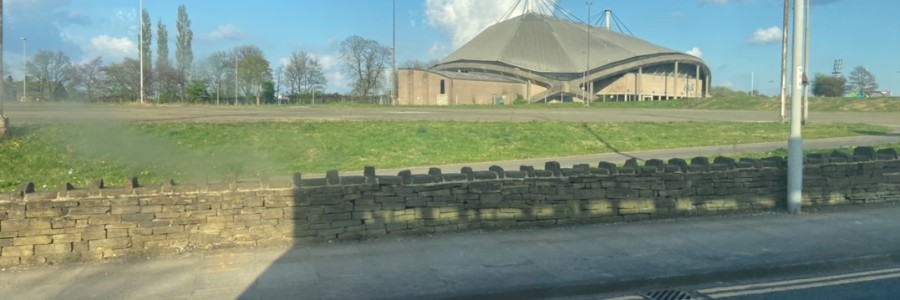Unlocking Civic potential: Redevelopment opportunities at the Richard Dunn Leisure Centre
Posted on 22 October 2025

Introduction
Across the UK, there are thousands of empty and abandoned properties, including civic buildings. These can range from disused libraries through to abandoned schools and leisure centres. Many of them are no longer used by the communities for which they were built, and have been left to deteriorate for years or even decades. Their past contributions to their surrounding neighbourhoods have largely been forgotten, with local residents dismissing them as eyesores. These buildings come with their challenges, but can also bring opportunities – many of them would be suitable for redevelopment and re-purposing. In this article, we will explore this issue further, using the Richard Dunn Leisure Centre in Bradford as a case in point. We’ll take a look at how civic buildings can be restored and brought back into use, the Richard Dunn Leisure Centre being a good example.
Design and History
At one time the Richard Dunn Sports Centre in Odsal,
Bradford was an iconic structure, renowned for its bold, yet unique
architectural features. It was widely recognised by local residents for its
tent-like, cable-stayed roof, its elliptical concrete arches, and its access
bridge, a striking feature which provided the interior with a dramatic,
theatrical atmosphere.
The Richard Dunn Sports Centre first opened its doors to the
public in 1978. It was named in honour of the Bradford-born boxer Richard Dunn.
Dunn was a scaffolder, and was working on the sports centre when he competed
for the heavyweight championship title.
The design of the building was pioneering for its time, as it
was one of the UK’s first buildings with computer-aided design for its
architecture. A genesys frame analysis computer programme was used to design the
cable stayed roof, a rare achievement in the 1970s, at a time when most
architectural work was carried out by hand.
The building was also one of the largest leisure centres in the local Bradford area, offering a wide array of facilities to the public, including a swimming pool, water slides, a gym, a sports hall, and more. During its lifetime numerous thrilling election counts were hosted there. But, while the 1970s witnessed a boom in leisure centre construction, many of these buildings have since fallen into disrepair.
Current Status
The building closed its doors in 2019. While
it had been operational, the Richard Dunn Centre had proved to be the most expensive
building for the council to maintain; its complex heating requirements making
it financially unviable. By the summer of 2020, Bradford Council was proposing
to demolish the building in its entirety, earmarking the land for use as a car
park and bus hub for the park and ride.
That same year, however, the onset of the pandemic meant that the council’s plans for the building had to be postponed. In the interim, the building's structure has suffered from vandalism and arson damage and it is now viewed as an eyesore, rather than an asset. Meanwhile, the costs have continued to mount: £150,000 a year being required just to secure and mothball the site. Reports of break-ins have continued to circulate, underscoring the challenges vacant civic buildings are currently facing and why there is an urgent need to do something about them.
In 2022 the C20 Society, which campaigns for the preservation of architectural heritage buildings post-1914, made a last-ditch effort to save the building from demolition. The bid was successful, and the building was granted Grade II heritage status, based on its significant architectural merits, historical significance and cultural value.
Listing and Skate Park Proposals
The proposals to demolish the structure were subsequently
scrapped and new plans have been proposed by the C20 Society to
turn the building into the UK’s first Olympic-level skate arena. If the plans progress, the building will be unique in offering a variety of terrains
and obstacles. It has the potential to attract significant numbers of spectators, and
would be reinvented with a new sense of purpose. As the plans have coincided with Bradford being named as the UK’s City of Culture for 2025, the
project stands out as a bold example of how post-industrial cities can unlock forgotten civic spaces and re-purpose them.
Drivers of Vacancy and Barriers to Building Re-use
Whilst the proposals for the building are ambitious, questions are bound to arise regarding the financial viability and deliverability of the skate park in the current economic climate. Its maintenance and energy costs alone, once developed, are likely to be significant given its size. The requirement for upgrades to meet modern standards, despite inflexible layouts, has often made maintaining such buildings infeasible, with an increased likelihood of long-term
vacancy and unoccupancy. Yet if barriers like these can be overcome, the
transformation of those neglected civic buildings could bring major cultural and economic benefits.
Conclusion
The Richard
Dunn Leisure Centre may well be a shining example of how dormant assets can be unlocked: hailed for its pioneering design in 1978, brought low over the years by significant vandalism and arson damage, but now facing the possibility of a new and dynamic future as a skate park. So far, the plans have received the backing of Skateboard GB and
other key stakeholders. Local residents who remember the building in its heyday are keen to see the building re-purposed and the site brought back into use. With a little imagination other cities across the UK could revitalize their underused civic spaces, and turn them into opportunities.
Other Articles
Development Land Value Calculator
Uncover the full potential of development land using our Development Value and Land Profit calculator.
Land Value Calculator